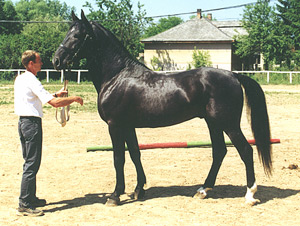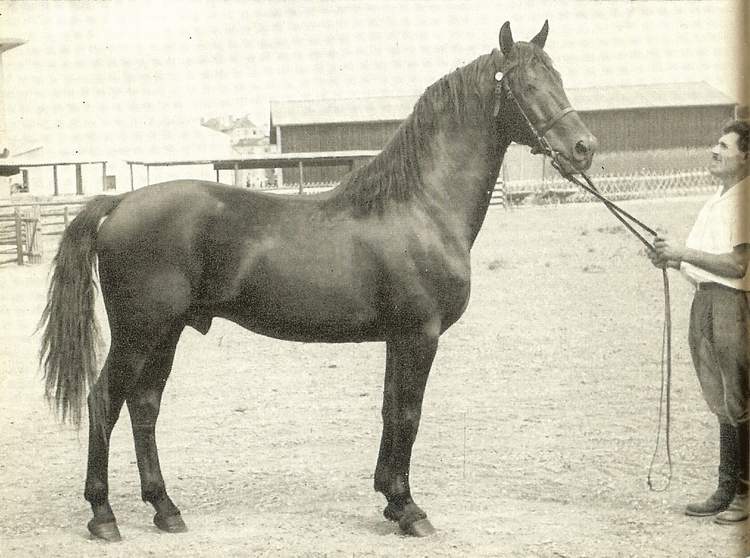

Nonius


Introduction: If you have any comments or suggestions, please click here. Evidently, there are two strains of the Nonius breed, one larger than the other, but until I see reason to, I will cover them both on this page.
Names: Nonius. Named after Anglo-Norman stallion that founded the breed.
Origin: Comes
from Hungary. Breeding areas and studs: Hungary: Comitat Czanad;
Stud: Mez§hegyes. Yugoslavia: Studs at Karadjordjevo, Napredak-Bajsa and
Lipik.
Two breeds of this fine saddle horse exist: the Large Nonius
and the Small Nonius. The parent breed was evolved in France in 1814 from
Anglo-Norman stock. Today the Nonius--usually both the Large and the Small
breeds--is used in Austria, Bulgaria, Hungary, Yugoslavia and Czechoslovakia.
The coloration in both breeds is solid brown, without markings. In size,
the large averages 65.1 inches and 1366 pounds; the Small 62.4 inches and 1153
pounds. Thus the Large is somewhat the heavier in build of the two.
Also in the Large the back is relatively longer and the tail placed lower than
in the Small. In both the chest girth in stallions averages larger than in
mares, thus showing a reersal of the proportions typical of Arabs,
Thoroughbreds, Standardbreds, and most other light horse breeds. Despite
this, the bodyweight in mares of the Large Nonius averages 12 pounds more than
in stallions, and in the Small 18 pounds more.
Breeding: Both Nonius strains (Large and Small) go back to Anglo-Norman blood. The progenitor of the breed was the stallion, Nonius, an Anglo-Norman captured from the French in 1814. During the last 100 years (written in the 1960s) the Small Nonius has had repeated admixtures of Thoroughbred, while the Large Nonius has been repeatedly given Anglo-Norman blood.
Description: Not particularly refined in appearance.
Action: Good. According to one source, the large strain has a good walk; a relatively flat, long-striding trot; and a powerful gallop. The small strain has an easy walk, brisk trot, great galloping ability, and good jumping capacity.
Body: Stately neck well set on. Strong withers. Back often weak, has too little barrel with narrow quarters. (Same source said the small strain has indifferent withers, rather long back, short quarters, well-muscled shoulders, and ample depth in the girth.)
Color: Black, bay or brown. Usually dark bay. Generally bay without markings.
Head: Relatively unrefined with smallish eyes.
Hooves: Medium-sized and well-formed.
Legs: Solid, healthy, and strong--sometimes, however, with rather weak pasterns. (Same source said the small strain has short, extraordinarily strong, well-muscled limbs with solid tendons and joints.)
Size: The two types, one more massive and up to 17 hands, the other about 15 hands (one source said about 15.2 hands), are both heavier than other breeds of Hungarian horses. The large strain is listed by one source as 16.2 to 17.2 hands, while the small strain is said to be 15.1 to 16.1 hands.
Temperament: Quiet and willing.
Features: The large strain of this breed is a heavy, strong, stately, elegant carriage horse of excellent, reliable character and lively temperament. It has good draught horse features and stamina, and is hardy and late in maturing (at about six years of age). The small strain is an all-purpose horse--not particularly handsome, yet an exceptionally fast, hardy, healthy, enduring, light warm-blood horse of happy temperament and good character.
Uses: They make useful farm and military horses and are particularly valuable for crossing with other breeds.
Accomplishments:
Curiosities:
Profiles:
Conclusion: